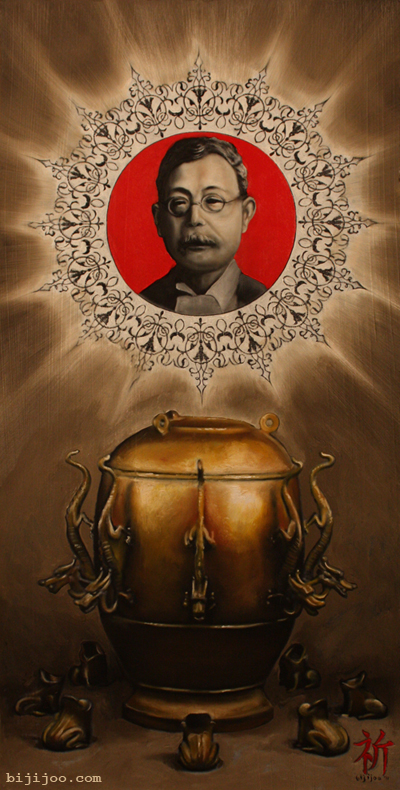 Fusakichi Omori’s Prayer. Oil on panel, 10in x 19in, 2011. click here for detail photos
Fusakichi Omori’s Prayer. Oil on panel, 10in x 19in, 2011. click here for detail photos
Portrait of Dr. George Washington Carver with Austin Wingate Curtis, Jr.
24in x 36in Oil on Panel
George Washington Carver was an American scientist, botanist, artist, educator, and inventor. “[He] did not know the exact date of his birth, but he thought it was in January 1864 (some evidence indicates July 1861, but not conclusively). He knew it was sometime before slavery was abolished in Missouri, which occurred in January 1864″[1].click here for detail photos
In 1942–45, mathematicians Samuel Eilenberg (right) and Saunders Mac Lane (left), introduced category theory as part of their work in algebraic topology. Category theory abstractly codifies the properties of mathematical concepts by formalising them as collections of objects and arrows (morphisms) which satisfy certain basic conditions. Significant areas of mathematics can be formalised as categories, and the use of category theory allows many intricate and subtle mathematical results in these fields to be stated, and proved, in a much simpler and elegant way than without the use of categories.
Categories can be used as a possible foundation of all of mathematics, thus replacing the use in such a foundation of the usual Zermelo-Fraenkel axioms for set theory. The category theory axioms orbit the heads of Eilenberg and Mac Lane shown in the painting.
Portrait of Ellen Swallow Richards, Chemist.
8.5″ X 11″ oil on acetate on wood.
Ellen Swallow Richards (December 3, 1842 – March 30, 1911) was the foremost female industrial and environmental chemist in the United States in the 19th century, pioneering the field of home economics. Richards graduated from Westford Academy (2nd oldest secondary school in Westford, MA). She was the first woman admitted to the Massachusetts Institute of Technology (MIT) and its first female instructor, the first woman in America accepted to any school of science and technology, and the first American woman to earn a degree in chemistry.
click here for detail photosPortrait of Max Planck, Theoretical Physicist
Max Planck (April 23, 1858 – October 4, 1947) was a German theoretical physicist, considered to be the founder of quantum theory, and thus one of the most important physicists of the twentieth century. Planck was awarded the Nobel Prize in Physics in 1918.
click here for detail photosPortrait of Andreas Vesalius, Anatomist
Andreas Vesalius (December 31, 1514 – October 15, 1564) was an anatomist, physician, and author of one of the most influential books on human anatomy, De humani corporis fabrica (On the Workings of the Human Body). Vesalius is often referred to as the founder of modern human anatomy.click here for detail photos
Portrait of Richard Feynman, Physicist
Richard Phillips Feynman (1918 – 1988) was an American physicist known for his work in the path integral formulation of quantum mechanics, the theory of quantum electrodynamics and the physics of the superfluidity of supercooled liquid helium, as well as in particle physics (he proposed the parton model).click here for detail photos